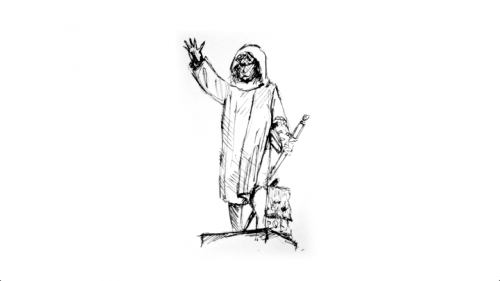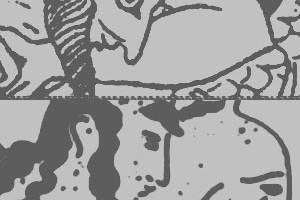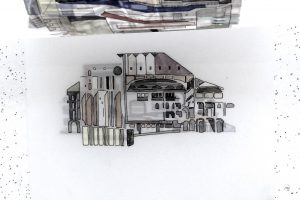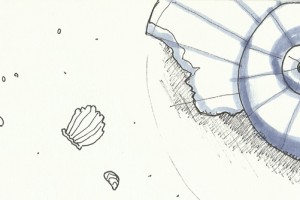In the Cultural History (or “ico”, short for iconography) stream at Waterloo Architecture, students delve into reading, writing, and thinking about the cultural forces that shape architecture. We page through dense philosophical tomes in the short days between studio deadlines, and brood upon the imagery of countless art films screened in class, cultivating ideas that make their way back into our design work. Finally, in our fourth year, we get to immerse ourselves in all of this while we live and study in Rome.
Elisabeth van Overbeeke’s “Place of the Lion: An Architectural Manifesto” was written for ARCH 448: Rome and the Campagna, taught by Eric Haldenby. The course assignment asks students to imagine the architecture of Rome through the eyes of a historical figure of their choice.
Place of the Lion: An Architectural Manifesto
by Elisabeth van Overbeeke
Introduction
“Place of the Lion” is a creative essay written from the perspective of Cola di Rienzo, an Italian popular leader who in the mid-14th century attempted to restore the structure of the Roman empire. He fictionally writes this piece while in prison in Avignon where he was imprisoned and being tried for heresy following his short six months as tribune. He reflects on three specific architectural spaces in their past glory and present deteriorated condition, as well as the meaning they embodied for the people of Rome across time. By inhabiting the spaces and describing Rienzo’s rise to power, the manifesto describes a role of architecture as being the purveyor of memory and emotion, and the witness of (sometimes mirrored) histories. His insights begin to offer a hint of irony not yet known to himself but apparent to readers who understand the repeated relevance of place in his own story.
My mind struggles to come back to reality and my eyes flicker open. I lay on a small cot in the center of a circular room of stone. It is cold and dark and I remember that I am in a prison cell at the height of a tall and wide tower overlooking Avignon. All sense of time is lost in this space. The calendar that I drew on the floor tells me that I have been here for almost three weeks now. It is only the books that the Pope allows me to keep and study that prevent me from losing my sanity. I try to occupy myself with the imaginings of other histories that are unconnected from my own. As hard as I try however, my mind always comes back to the events of my own life as they themselves are no small thing. I look to the future, hoping and praying that my hasty charge of heresy will be revoked by the Pope. Then my mind focuses on the past and I see a sequence of events that I would not have changed: as though it was a divined path that I took to bring me to this very place and time. I keep asking myself questions: Why are people so fickle, adoring their leader one day and forsaking him the next? Why can’t they see what I see, a carcass of a city that could be as glorious as it once was?!
My mind shifts back to my childhood. When I wanted a rest from my studies and when it was safe enough, I loved walking through the streets of Rome. I was a talented scholar and had a gift of being able to see and imagine the possibilities around me. One of my favourite places to go was the Pantheon. I approach the monument and unlike others whose minds numb at the sheer volume of impressions, unable to receive all of the information or to react to it, I see every detail of the space as it once was and revel in it! I walk through the portico and I feel as though I am being transformed as I am drawn through the filtered haze of light between the columns, as if to prepare me to cross a threshold into a holy place. I am in awe of the symmetry and balance of the empty, large, domed space in the interior, like everything in the universe is in a perfect balance. I am convinced for a brief moment of the existence of a harmonious gathering of many gods as I regard the many flawless stone figures framed in the walls up above. I stay in the building as long as I can just so that I can follow the sun as the circle of light crawls across the coffers of the ceiling and hits the bright and shining hues of the patterned marble walls and floor. Just like my prison cell, time becomes something different in this space, as it shuns the habitual activity of the outside world and just simply exists as the sun exists, an eye to the heavens. This temple is built to endure an eternity and therefore does not require too much reconstruction of the imagination to bring it back to its past glory; a house of the gods was simply transformed into a house for the one god.
A sad contrast can be seen as one walks out of the abitato; the buildings of the people do not receive near as much respect as the buildings of the deities. Where the Roman fori once stood in all their glory, now stand ruins, half buried, covered in overgrowth of shrubs and wild vines. I walk through the field of pillage and imagine what I read about in Livy’s histories: large, symmetrical, rectilinear marketplaces surrounded by long and glorious colonnades. On a market day I can hear the sounds of musicians, the clinking and clanging of tools and pots, of peasants and buyers bartering, or a child crying. I smell the aromas of delicious foods and spices, and sometimes the more unpleasant odours of refuse, animals, or dust come across my nostrils. The sun feels hot on my forehead, but the awnings over many a table offer temporary relief. The fora is a true witness to the thriving economy and power of Rome, a theatrical stage which plays out the events of the simple man and the politician alike. Crowds gather to rejoice during a holyday, to cheer or mock a speaking politician, or to witness a trial or an execution. Unlike the enclosed and independent space of the Pantheon, the fora is under constant influence from its surroundings.
I walk even further out of the city until I approach the tall, vacant form of the Baths of Caracalla. This is the place I would venture to now and again with my brother, where we would sit within the privacy of the crumbling vaults and walls, and my more soft-tempered brother would graciously listen to my crazy stories and outlandish schemes. The baths, although also symmetrical in form, were built to absorb visitors into a separate world of relaxation and leisure. I imagine it as it was, a walled paradise, full of people of various sex and station, stripped down of their signs of status to the naked skin shared by all human being. Small chambers and saunas surround medium sized pools that encompass large halls and a grand central pool. The building is a maze of halls and rooms, each with pools of varying temperature, depth, and aroma. I hear the sounds of idle chatter and of the continuous rushing of small waterfalls. The intricate, glistening mosaic marble floors meet with hundreds of bare feet, and the towering marble walls house niches of rich statuary that look on with empty eyes. I wake up from my reverie and see once more the pillaged ruins. It brings tears to my eyes as I see sacred pieces and traces of such a glorious past being snatched up and carelessly placed in the wall of a battlement or tower of the nobles. They care little about what the glorious buildings of the past stood for and only use the fragments for their own personal vendettas.
As I grew older I began to be aware of my own interesting position among the people and the nobles, and discovered my own ability with words. I was a skilled orator, and could weave together amazing, descriptive images with words. I began to realize that I could inspire the people with images painted from the past. It was a truly powerful skill that I began to use, and the moment I was selected as an ambassador for the Pope in Avignon, it was as if my entire path from that moment was set before me. I began to work myself up in the graces of the nobles, and at the same time began to befriend and ally with the people, as I myself was one of them. When I described to people a revived Rome, I didn’t speak of the political jargon that the common man does not understand; no, I spoke of the very stones that they stood on! To those stones they could relate, and it was those stones that preached not only the form of a space, of the use of materials, or even the passage of time, but preached loud and clear the embodiment of the desires of a city and a nation. With my words I woke the Pantheon from it’s deep slumber and it became once again in the minds of the people a symbol of Roman power and an equality among the gods and among the Roman people. At my words the marketplaces of ancient Rome spoke of the liberties they once embodied and the power of a thriving economy. The baths preached of a nation that knew how to relax and enjoy the peace and wealth of the state. What an affect these words had on the people before me, Romans now stripped of many liberties, struggling to put food on their tables, and afraid to even step into the streets that were the battle ground for the combative, unsatiated, power-thirsty nobles. “Inscriptions, displaced and reused columns, capitals, alters, sarcophagi, and arches – newly whispered aspirations to grandeur, of the promise of rebirth in a new age (Musto, 2003).”
Time is a strange phenomenon; history repeats itself again and again as sure as the level of the Tiber rises and falls. The nations rise and fall, and rise again as though humanity has no control. Since the moment that the emperor Constantine was baptized in the font in the Lateran, the fallen state of humanity had been spiritually reformed; however, Rome was still in a physical devastation and it was foretold that a new reformation would yet come for the mourning city. I saw it before me as clear as day that I was to be the person who would bring about the inevitable revolution. The Good Estate did not last even a year, but I believe my role in this history is not yet complete. I did not baptize myself in the font of Constantine to desecrate the religious artifact, but rather the action was meant as a symbol of the revisiting of history, the second reformation. When Rome welcomes its next Pope, I plan to use my words to win his good graces, and again return to Rome to finish what I began. I have built many an architecture with words, but how I long to build something real. I want to do what all men who led Rome in antiquity did: write my name on the city of Rome with a monument, similar to the Arch of Constantine and the other monuments of many an emperor. This way I will be forever written in the histories of Rome and join the city in its eternal existence! I would place my monument at the Place of the Lion for it holds much significance to the rise of the Buono Stato. Beside that very lion I spoke for the first time to the people, and it was below that very same statue that I wrote the inscription with the promise that I would return! “Dread statue! How many unwhispered and solemn rites have you witnessed by your native Nile, before the Roman’s transferred you here – the antique witness of Roman crimes! Strange! but when I look upon you I feel as if you have some mystic influence over my own fortunes (Lytton, 1835).” Architecture stands the truest witness to these strange ironies of twisted fate.
Cola di Rienzo, first Tribune of Rome, July 1352
Epilogue
After being released from prison Cola di Rienzo would return to Rome and rise quickly back to power, but then would just as quickly lose the following of the people. Based on the history as Lytton and later, Musto, depict it, Cola di Rienzo dies at the hands of an angry mob while giving a speech at the Place of the Lion, the very place that held so much significance for him (Lytton 1835, Musto 2003). He leaves behind a romantic legacy that is adopted in the nineteenth century as an icon of the Italian unification and was the subject of the famous book Rienzi by Edward Lytton and an opera composed by Richard Wagnar that was based on the book. It was during this period, several hundred years after the life of Rienzo, that his statue is erected at the foot of the Capitoline Hill, overlooking the same Place of the Lion. A replica of this statue stands in the vestibule of the Rome Studio (at least it did in fall 2011) and is what prompted my initial curiosity to find out who it depicted. When I discovered the twin statue at the Capitoline hill and learned who it was and the story behind it, I decided to do the extra research and write the manifesto from the perspective of this interesting personage who, like many before and after him, strove to bring back the glory of ancient Rome.
Musto, Ronald G. Apocalpyse in Rome: Cola di Rienzo and the Politics of the New Age. University of California Press, 2003.
Bulwer Lytton, Edward. Rienzi: The Last of the Roman Tribunes. George Routledge and Sons, 1835.
Illustration by Author.
The Archi-TEXTS series celebrates written student work at Waterloo Architecture. Ongoing submissions are welcome at submit@waterlooarchitecture.com






Leave a Reply